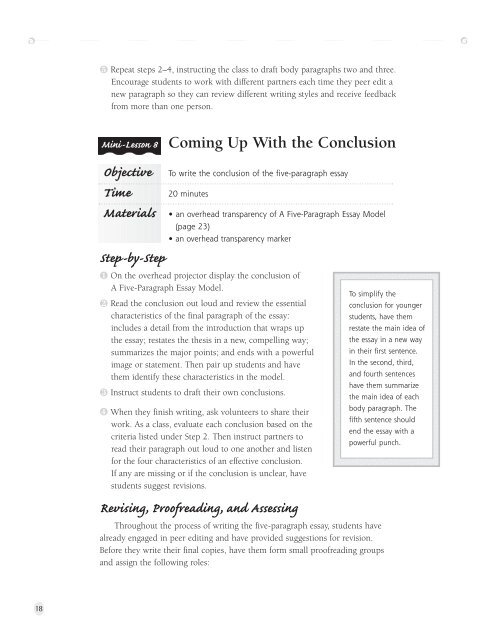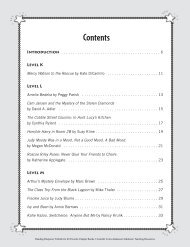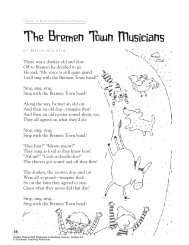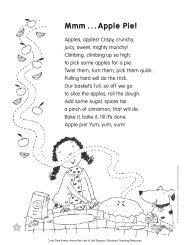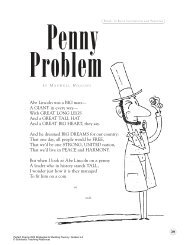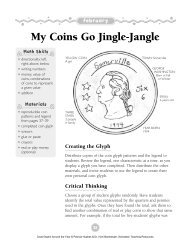Narrative Essay - Scholastic Store
Narrative Essay - Scholastic Store
Narrative Essay - Scholastic Store
You also want an ePaper? Increase the reach of your titles
YUMPU automatically turns print PDFs into web optimized ePapers that Google loves.
18<br />
❺ Repeat steps 2–4, instructing the class to draft body paragraphs two and three.<br />
Encourage students to work with different partners each time they peer edit a<br />
new paragraph so they can review different writing styles and receive feedback<br />
from more than one person.<br />
Mini-Lesson 8 Coming Up With the Conclusion<br />
Objective To write the conclusion of the five-paragraph essay<br />
Time 20 minutes<br />
Materials • an overhead transparency of A Five-Paragraph <strong>Essay</strong> Model<br />
(page 23)<br />
• an overhead transparency marker<br />
Step-by-Step<br />
❶ On the overhead projector display the conclusion of<br />
A Five-Paragraph <strong>Essay</strong> Model.<br />
❷ Read the conclusion out loud and review the essential<br />
characteristics of the final paragraph of the essay:<br />
includes a detail from the introduction that wraps up<br />
the essay; restates the thesis in a new, compelling way;<br />
summarizes the major points; and ends with a powerful<br />
image or statement. Then pair up students and have<br />
them identify these characteristics in the model.<br />
❸ Instruct students to draft their own conclusions.<br />
❹ When they finish writing, ask volunteers to share their<br />
work. As a class, evaluate each conclusion based on the<br />
criteria listed under Step 2. Then instruct partners to<br />
read their paragraph out loud to one another and listen<br />
for the four characteristics of an effective conclusion.<br />
If any are missing or if the conclusion is unclear, have<br />
students suggest revisions.<br />
Revising, Proofreading, and Assessing<br />
Throughout the process of writing the five-paragraph essay, students have<br />
already engaged in peer editing and have provided suggestions for revision.<br />
Before they write their final copies, have them form small proofreading groups<br />
and assign the following roles:<br />
To simplify the<br />
conclusion for younger<br />
students, have them<br />
restate the main idea of<br />
the essay in a new way<br />
in their first sentence.<br />
In the second, third,<br />
and fourth sentences<br />
have them summarize<br />
the main idea of each<br />
body paragraph. The<br />
fifth sentence should<br />
end the essay with a<br />
powerful punch.
Spell Checker—circles misspelled words and labels them sp .<br />
Sentence Monitor—brackets and labels run-ons, fragments, and sentences<br />
that do not make sense. [ ] R.O. [ ] Frag. [ ] S.S.<br />
Mechanics Person—uses proofreading symbols to show the writer where to<br />
correct capitalization and punctuation.<br />
As the essay drafts are passed from one group member to another, each<br />
person proofreads the paper, checking only the element he or she has have been<br />
assigned. If you choose to have students take a final look at the organization of the<br />
essay, ask partners to exchange papers and use the reproducible General Editing<br />
Checklist for the Five-Paragraph <strong>Essay</strong> (page 27) to review their work. Instruct<br />
the class to use the following symbols to fill in the blanks on the checklist:<br />
✓ = everything is included<br />
✓– = needs work<br />
0 = not there<br />
I always hand out a copy of the General Editing Checklist for students to keep in<br />
their notebooks. Each time we write an essay, I encourage them take out the list<br />
and review it carefully.<br />
Assessment<br />
To assess each student’s completed paper, I use the<br />
Rubric for a Five-Paragraph <strong>Essay</strong> (page 28), an analytic guide<br />
based on the criteria defined by the Pennsylvania Department<br />
of Education: focus, organization, content, usage, and style.<br />
I like this rubric because it is generic enough to use with<br />
most five-paragraph essays.<br />
Although the steps involved in introducing a thoughtful,<br />
well-constructed essay are time-consuming, the end product<br />
is worth the effort. The process outlined here is the most<br />
effective one I have used to date; quite simply, it has improved<br />
the quality and content of my students’ essay writing. I believe<br />
the process works well because of the strategies employed.<br />
Modeling, repetition, practice, peer interaction, graphic<br />
organizers, and color coding are all supported by current<br />
brain research (Jensen, 1998; Sprenger, 1999).<br />
Teacher<br />
Have students bring<br />
in photographs or<br />
draw pictures of the<br />
heroes referred to in<br />
their essays. Create a<br />
bulletin board display<br />
or a Student Heroes<br />
book. Read a few of<br />
the essays out loud on<br />
Back-to-School Night.<br />
19
CHAPTER 1—REPRODUCIBLE 3A<br />
The introduction<br />
begins with an<br />
attention-getting<br />
sentence and<br />
moves from<br />
general statements<br />
about the topic<br />
to the specific.<br />
Finally, it ends<br />
with a three-point<br />
thesis statement<br />
that states the<br />
main idea of<br />
the essay and<br />
briefly outlines<br />
the topics of the<br />
body paragraphs.<br />
Mastering the Five-Paragraph <strong>Essay</strong> <strong>Scholastic</strong> Teaching Resources<br />
A Five-Paragraph <strong>Essay</strong> Model<br />
The Prompt<br />
Heroes are a valuable part of our world and everyone’s<br />
daily life. Identify qualities or traits heroes possess and<br />
provide examples of these qualities.<br />
Explain why these qualities are important.<br />
Qualities of an Extraordinarily<br />
Ordinary Hero<br />
Abraham Lincoln and Spider-Man are not the only<br />
heroes in the world. Heroes can be ordinary people like<br />
you and me. They can be as young as a child or as old<br />
as a senior citizen. However, as different as they might<br />
be, ordinary heroes like my Grandma Jean possess<br />
universal qualities, such as courage, determination,<br />
and compassion.<br />
Courage, which is undoubtedly a trait that most<br />
heroes possess, motivates people to make positive<br />
changes in the world. In a society that believed a<br />
woman’s place was in the home, my grandmother’s inner<br />
strength and courage allowed her to break the mold.<br />
During the 1930s she worked on Wall Street as the art<br />
editor for Good Housekeeping magazine, and later in her<br />
life she became the country’s first Cattlewoman of the<br />
Year. Even though she was frequently the only woman<br />
in a room filled with hundreds of men, Grandma Jean<br />
still had the courage to gracefully stride up to the podium<br />
to speak about the new genetic techniques that she<br />
designed to help ordinary cattlemen improve the quality<br />
of their herds. In short, her inner strength and courage<br />
allowed her to serve as an advocate for women’s rights.<br />
The topic sentence<br />
of the body<br />
paragraph relates<br />
back to the first<br />
point of the thesis.<br />
It describes a heroic<br />
quality and explains<br />
its importance.<br />
The writer then uses<br />
three specific details<br />
and examples to<br />
illustrate the heroic<br />
quality of courage.<br />
The clincher<br />
sentence begins with<br />
a transition word<br />
and summarizes the<br />
main idea.<br />
23
24<br />
CHAPTER 1—REPRODUCIBLE 3B<br />
The writer uses a<br />
transition word,<br />
“another,” to<br />
introduce the<br />
second quality a<br />
hero possesses.<br />
The topic sentence<br />
relates back to<br />
the second point<br />
of the thesis.<br />
Again, three<br />
detail sentences<br />
illustrate the<br />
heroic quality.<br />
A concluding<br />
sentence summarizes<br />
the main idea.<br />
The conclusion<br />
includes a<br />
detail from the<br />
introduction to<br />
wrap up the<br />
essay. It restates<br />
or echoes the<br />
thesis statement,<br />
summarizes the<br />
main points,<br />
and ends with<br />
a powerful<br />
statement.<br />
Another admirable quality that heroes possess is<br />
determination, which enables many people to overcome<br />
challenges and difficult situations. Determined to help my<br />
invalid, wheelchair-bound grandfather live a normal life,<br />
my grandmother invented a creative way for him to<br />
roam the cattle pastures. Grandma Jean actually bought<br />
and renovated a Checker taxicab! Every afternoon she<br />
maneuvered my grandfather’s lift and drove him from one<br />
field to another in his comfortable, king-size automobile.<br />
Without my grandmother’s determination and creativity,<br />
my grandfather would have been trapped inside the<br />
house in his wheelchair unable to view his beloved land<br />
and livestock.<br />
Although courage and determination are heroic traits,<br />
perhaps the most important quality is compassion.<br />
Without a doubt, caring about others and helping those<br />
in need make the world a more humane place to live.<br />
For 15 years my grandmother tirelessly and selflessly<br />
cared for my grandfather. Because he literally had no<br />
muscles, Grandma Jean awoke every hour on the hour<br />
each night to turn my grandfather on his side or back so<br />
that he would not get bedsores. When Pop-Pop’s hands<br />
and arms no longer worked, my grandmother fed him,<br />
shaved him, and combed his hair. Even in the face of her<br />
own devastating battle with cancer, my grandmother<br />
continued to show deep compassion by comforting and<br />
reaching out to my grandfather, other cancer patients,<br />
and her own family.<br />
Heroes like my grandmother are not as extraordinary<br />
as Abraham Lincoln or Spider-Man. However, their<br />
courage, determination, and compassion inspire<br />
others to make changes, overcome obstacles, and reach<br />
out to those in need. Heroes are our beacons, our guides,<br />
the people who individually and collectively promote<br />
peace, justice, love, and understanding. Because of them,<br />
our world is a better, richer place to live.<br />
The topic sentence<br />
of the third<br />
paragraph relates<br />
to the third point<br />
of the thesis and<br />
connects back to<br />
body paragraphs<br />
one and two. It<br />
also has three detail<br />
sentences and a<br />
clincher. Also, the<br />
writer organizes the<br />
information in the<br />
body from least<br />
important to most<br />
important.<br />
Mastering the Five-Paragraph <strong>Essay</strong> <strong>Scholastic</strong> Teaching Resources
CHAPTER 1—REPRODUCIBLE 4<br />
Fights for<br />
women’s rights;<br />
art editor<br />
Model Web for Qualities of a Hero<br />
Becomes first<br />
Cattlewoman of<br />
the Year<br />
Courage<br />
(helps people make<br />
changes in the world)<br />
Selflessly cares<br />
for Pop-Pop<br />
Speaks to group<br />
of many men<br />
Mastering the Five-Paragraph <strong>Essay</strong> <strong>Scholastic</strong> Teaching Resources<br />
Turns Pop-Pop<br />
over every hour<br />
Decides to<br />
free Pop-Pop from<br />
wheelchair<br />
Qualities of a Hero<br />
(Grandma Jean)<br />
Compassion<br />
(makes world a<br />
better place)<br />
Determination<br />
(enables people to<br />
overcome difficulties)<br />
Feeds and<br />
shaves Pop-Pop;<br />
combs his hair<br />
Buys taxicab<br />
25
! C HAPTER 3 }<br />
<strong>Narrative</strong> <strong>Essay</strong><br />
Background Information<br />
he Personal<br />
When the Department of Education instituted the Pennsylvania State<br />
Writing Assessment, which includes narrative, informational, and<br />
persuasive writing, I taught the narrative essay first. However, now I<br />
begin with informational writing because of the unique structure inherent in personal<br />
narratives. Rather than following the regular, definable patterns of the informational<br />
or persuasive essay, a personal narrative tells a story about an individual experience,<br />
situation, or event or a “proposed occurrence at a particular time in a particular<br />
place.” (Pennsylvania Department of Education/Division of Evaluation and Reports,<br />
2001–2002, p.8) Another reason that I used to begin with the personal narrative<br />
rather than the informational essay is that initially I thought students would have an<br />
easier time writing about themselves. Wrong! Surprisingly, many of their personal<br />
accounts were dull, boring, and lifeless. Consequently, after I teach students about the<br />
structure of the narrative essay, I engage them in revision activities similar to those<br />
included in this chapter to help them add detail, color, and description to their writing.<br />
Mini-Lesson Writing Personal <strong>Narrative</strong> <strong>Essay</strong>s<br />
Objective To model a personal narrative essay<br />
To generate a list of the characteristics of the personal<br />
narrative essay<br />
To prewrite, draft, revise, and edit a five-paragraph personal<br />
narrative essay<br />
Time One to three 40-minute class periods<br />
43
44<br />
Materials • an overhead transparency and photocopies of the Personal<br />
<strong>Narrative</strong> <strong>Essay</strong> Model (page 50)<br />
• photocopies of the Personal <strong>Narrative</strong> <strong>Essay</strong> Editing Sheet<br />
(page 52)<br />
Step-by-Step<br />
❶ Write the phrase narrative essay on the board. Challenge students to define<br />
narrative writing and provide examples of it. Differentiate between a personal<br />
narrative essay and a fictional short story. Ask students to discuss some of the<br />
similarities and differences between the two.<br />
❷ Make and distribute a copy of the prompt below or write it on the board.<br />
Again, I link my prompts to the literature we are currently studying. In this<br />
case the class has just finished reading “The Necklace” by Guy de Maupassant.<br />
Read the prompt out loud to students and have them note the key words.<br />
Also, challenge them to state the topic and purpose of the prompt (topic:<br />
making a decision; purpose: to show the consequences of the decision).<br />
The Prompt<br />
In “The Necklace” by Guy de Maupassant, Madame Loisel and<br />
her husband make a fateful decision. They deliberately choose to<br />
be dishonest, and the consequences of their decision haunt them<br />
for a decade.<br />
Like Madame and Monsieur Loisel, all of us are required to<br />
make decisions and choices in our lives.<br />
Describe a time or event in your own life in which you<br />
were faced with making a decision or a choice. Show the<br />
consequences of your decision.<br />
❸ Show the essay model “Promises Are Not Meant to Be Broken” on the<br />
overhead projector. Read it out loud, and use it to elicit the characteristics or<br />
features of narrative writing from students. Write their responses on the board<br />
or on chart paper. Guide them to discover that a five-paragraph personal<br />
narrative essay has the following characteristics:<br />
• tells a story about a personal experience, situation, or event that occurs<br />
in a specific place at a specific time;<br />
• uses some story elements, such as setting, plot, and characters;
• has a central or controlling idea that makes a point or conveys a message;<br />
• includes an introduction with an attention-getting opening sentence,<br />
provides background information about the topic or experience, and<br />
contains a modified thesis statement in the last sentence that conveys<br />
the main idea of the essay;<br />
• contains three body paragraphs;<br />
• has an effective ending or conclusion that can sometimes reveal what the<br />
narrator has learned, provide food for thought, or create a powerful image<br />
or feeling;<br />
• is usually told from the writer’s, or first-person, point of view;<br />
• is often arranged in chronological or sequential order;<br />
• uses sensory detail, precise language, and some dialogue.<br />
Note: As students compile a list of characteristics for each kind of essay, I jot<br />
down the title of the essay type at the top of a piece of chart paper. Then I<br />
add the features that students have come up with and post the list. Every time<br />
we focus on one of the essay types, I hang up the chart paper, which I have<br />
laminated, so that students can review that essay’s particular characteristics.<br />
❹ Have students individually<br />
brainstorm a list of situations<br />
CHAPTER 3—REPRODUCIBLE 1<br />
in which they had to make an<br />
Model Web for Personal <strong>Narrative</strong> <strong>Essay</strong><br />
important decision. Some examples<br />
my students have used are whether<br />
Remember<br />
my promise<br />
to my dad<br />
Hide behind<br />
stairwells<br />
or not to join a team, put an animal<br />
to sleep, attend a new school,<br />
In the middle of<br />
action-packed show<br />
told to go to bed<br />
Battle conscience:<br />
Should I go to<br />
bed or not?<br />
Become hooked<br />
on the show<br />
disobey a parent, and get a job. By<br />
this time, students should be able<br />
Face doubt<br />
Choose the<br />
wrong path<br />
to construct a Rule of Three web<br />
for their essay (see Mini-Lesson 4,<br />
My Decision<br />
and Its<br />
Consequences<br />
page 12). If they need assistance,<br />
use the ideas in the model essay to<br />
Suffer<br />
consequences<br />
help them. Again, instruct them to<br />
draft their essay.<br />
Fail to see Dad<br />
enter living<br />
Dad forbids me<br />
to watch TV<br />
Disappoint<br />
Dad who reminds<br />
me not to break a<br />
promise<br />
❺ When students complete their<br />
drafts, divide them into pairs or<br />
into groups of three or four. After<br />
distributing copies of the Personal <strong>Narrative</strong> <strong>Essay</strong> Editing Sheet, instruct<br />
group members to use the handout to edit each other’s essay. Before<br />
beginning, you may want to spend some time explaining the various<br />
guidelines presented on the editing sheet.<br />
Decide to watch<br />
rest of show<br />
49<br />
45
46<br />
A Revision Strategy for Adding Detail<br />
Often my students’ personal narratives lack vitality and description. For<br />
example, in one such essay Cassie writes about the struggles she endured when<br />
joining the softball team. After discovering she was the worst player on the team,<br />
Cassie practiced diligently and improved tremendously. However, as this<br />
award-winning writer describes the momentous occasion of receiving the<br />
Most Improved Player award at the team picnic, she writes,<br />
It warmed my heart to learn others understood my<br />
struggle and were impressed with my success.<br />
They were proud of me.<br />
Even the best authors benefit from strategies that teach them how to enhance their<br />
writing style. Instead of becoming discouraged by flat description in your students’<br />
writing, seize the opportunity to teach a revision strategy. The following is a<br />
variation of Laura Harper’s snapshots revision strategy described in the March 1997<br />
issue of Language Arts.<br />
❶ Write Cassie’s quotation (see above) on the board or use a passage by a former<br />
student that lacks colorful details. Set the stage for the context of the quotation.<br />
In this case, explain that to overcome the obstacle of being the worst player on<br />
the team, Cassie spent countless hours practicing in the batting cage and throwing<br />
and catching with her brother. Then, in a critical game, with a runner on third,<br />
two outs, and the team down by a run, Cassie smacked the ball. The player on<br />
third base streaked down to home plate, and Cassie’s team triumphantly won the<br />
game! As a result, she earned the Most Improved Player award. The quotation<br />
above described her feelings as she received the award.<br />
❷ Next, have students zero in on the action of Cassie receiving the Most Improved<br />
Player award. Discuss some of the details Cassie could have included to show<br />
the thrill of the moment. Then, using some of the details discussed, have<br />
students create a cartoon frame and draw a picture of Cassie receiving the<br />
award. Ask students to write a two- or three-sentence caption describing the<br />
picture, as illustrated below.<br />
My teammates, coach,<br />
and parents smiled<br />
broadly as I accepted<br />
the gleaming, gold<br />
Most Improved Player<br />
award. I really felt as if<br />
my insides were about<br />
to burst.
❸ Now instruct students to zoom in on one of the details in their first drawing<br />
and create a second picture that focuses on that single detail. For example,<br />
one student may choose to highlight the award recipient’s face; another may<br />
choose to concentrate on the trophy; and a third may focus on the coach’s<br />
face. Below the second picture, have students write a two- or three-sentence<br />
description that is similar to the one below.<br />
Beaming with pride, my coach’s<br />
face could barely contain<br />
his broad, wide smile. He was all pearly<br />
whites and dimpled cheeks.<br />
❹ Finally, have students draw a third picture, in which they zoom in even closer<br />
on a detail in the second picture. For instance, in the example above, the<br />
student may choose to focus only on the coach’s smile as depicted below.<br />
Again, have students write a two- or three-sentence caption for this picture,<br />
as shown below.<br />
The coach’s smile stretched as<br />
wide as a watermelon slice, and his<br />
dimples folded back into his face<br />
like an accordion. His pride<br />
swallowed me up and enlarged<br />
my heart twofold.<br />
❺ After students share some of their drawings and captions, demonstrate how<br />
to use the process of focusing on a specific detail to revise Cassie’s original<br />
passage. Use the one below or create your own.<br />
Revision<br />
As my coach presented me with the Most Improved Player award,<br />
his smile stretched as wide as a watermelon slice, and his dimples<br />
folded back into his face like an accordion. His pride swallowed me<br />
up and enlarged my heart twofold.<br />
❻ Challenge students to find a passage in their own personal narrative that<br />
needs further description. Have them follow the steps listed above to revise<br />
the passage.<br />
47
48<br />
Activities to Help Students Add Detail to<br />
Personal <strong>Narrative</strong>s<br />
• Instead of starting the writing process with a list, web, or outline, begin<br />
with a guided journal entry that relates to the topic of the narrative essay.<br />
For example, if students are writing about a time when they were required<br />
to make an important decision, have them think about decisions they<br />
have made in the past and choose one to focus on in their journal. As they<br />
write, prompt them to add detail to their entries by asking lots of questions<br />
similar to the following:<br />
Where were you when you made the decision? Were you inside or<br />
outside? What did the walls or landscape look like? What kind of<br />
furniture was in the room, or what kind of birds and trees did you<br />
see? What did you smell? Who was there? What were they wearing?<br />
What patterns and colors did you see on their shirt or dress? Describe<br />
their scent and their facial expressions. What shape were their eyes?<br />
What kind of eyebrows did they have? How did you feel as you<br />
weighed the pros and cons of your decision? What were your inner<br />
thoughts? What did your conscience say to you? Who influenced<br />
your thinking? What were they saying? Were your hands loose or<br />
balled up in fists? How did your stomach feel? Your knees?<br />
After students finish the entry, have them highlight or underline details they<br />
can use in their essay. Encourage them to group relevant details together.<br />
• Create several sensory word banks for the classroom. First put decorated<br />
shoe boxes that are labeled “Sight,” “Sound,” “Taste,” “Touch,” and “Smell”<br />
around the room. Then place pencils and index cards beside each box.<br />
As students read stories, novels, and class work, have them find powerful<br />
sensory words. When they encounter one, direct them to write it on an<br />
index card and place it in the appropriate box. Encourage students to use<br />
the word banks as a writing resource. When they have collected at least<br />
20 cards, compile a list of all the words and distribute it to the class.<br />
Finally, remind students to pull out the list whenever they have a writing<br />
assignment. You might even try creating an entire sensory word wall.<br />
• Instruct students to find four or five vivid verbs in the essay “Promises<br />
Are Not Meant to Be Broken” such as leaped, plastered, seesawed, zip, and<br />
trickled. Next, have them highlight the verbs contained in their drafts and<br />
change four or five of them to make them more descriptive. Ask volunteers<br />
to physically act out a pair of their verbs to show the change in meaning.<br />
For example, if they substituted the verb meandered for walked, tell them to<br />
walk and then to meander.
CHAPTER 3—REPRODUCIBLE 1<br />
Model Web for Personal <strong>Narrative</strong> <strong>Essay</strong><br />
In the middle of<br />
action-packed show<br />
told to go to bed<br />
Remember<br />
my promise<br />
to my dad<br />
Face doubt<br />
Fail to see Dad<br />
enter living room<br />
Battle conscience:<br />
Should I go to<br />
bed or not?<br />
Mastering the Five-Paragraph <strong>Essay</strong> <strong>Scholastic</strong> Teaching Resources<br />
My Decision<br />
and Its<br />
Consequences<br />
Suffer<br />
consequences<br />
Disappoint<br />
Dad, who reminds<br />
me not to break a<br />
promise<br />
Become hooked<br />
on the show<br />
Hide behind<br />
stairwell wall<br />
Choose the<br />
wrong path<br />
Dad forbids me<br />
to watch TV<br />
Decide to watch<br />
rest of show<br />
49
50<br />
CHAPTER 3—REPRODUCIBLE 2A<br />
The anecdote, or<br />
“little story,” in the<br />
introduction provides<br />
background<br />
information for<br />
the narrative<br />
essay. The last<br />
sentence is a<br />
modified thesis<br />
statement that<br />
outlines the three<br />
consequences of<br />
the decision.<br />
A clincher<br />
sentence<br />
summarizes<br />
the information.<br />
Personal <strong>Narrative</strong> <strong>Essay</strong> Model<br />
Promises Are Not Meant<br />
to Be Broken<br />
My heart leaped with excitement! My hero (a.k.a.<br />
my dad) was taking care of my older brothers and me.<br />
At the very least, this meant chocolate marshmallow<br />
ice-cream cones and maybe even the privilege of staying<br />
up past 8:00 P.M. Clean, polished, and properly p.j.’d,<br />
I plastered my charming five-year-old smile on my face<br />
and politely begged to watch Wagon Train, a show that<br />
ended at 9:00, with my brothers. To my great delight<br />
Dad caved in but made me promise to go to bed at 8:30.<br />
Happily I crossed my heart and pledged to do as I was<br />
told. Little did I know that later I would face a decision<br />
that would fill me with doubt, cause me to disobey my<br />
dad, and lead me to suffer the unhappy consequences.<br />
Along with The Lone Ranger, Wagon Train promised<br />
to become one of my favorite television shows. Filled<br />
with western frontier action, the trials and tribulations<br />
of America’s early pioneers kept me and my siblings on<br />
the edge of our seats. Right in the middle of a dramatic<br />
showdown, my oldest brother told me it was 8:30, time<br />
for me to go to bed. Although a small voice whispered,<br />
“Remember what you promised Dad,” a louder voice<br />
shouted, “Hide somewhere so you can see whether<br />
Cookie gets scalped!” Back and forth, up and down my<br />
conscience seesawed. Doubt clung to me like a wide<br />
strip of Velcro.<br />
The first body<br />
paragraph relates<br />
to the first point<br />
of the modified<br />
thesis statement.<br />
It uses some<br />
dialogue, vivid<br />
verbs, and<br />
figurative language.<br />
Mastering the Five-Paragraph <strong>Essay</strong> <strong>Scholastic</strong> Teaching Resources
CHAPTER 3—REPRODUCIBLE 2B<br />
The second body<br />
paragraph shows<br />
the narrator<br />
chooses the<br />
wrong path, the<br />
second point in<br />
the modified<br />
thesis statement.<br />
The conclusion<br />
shows what the<br />
narrator learns<br />
from making her<br />
decision.<br />
Mastering the Five-Paragraph <strong>Essay</strong> <strong>Scholastic</strong> Teaching Resources<br />
“Bang!” The battle against the Indians began, and I<br />
was hooked. Pretending to head toward bed, I stealthily<br />
crept behind the stairwell wall. From there I had a clear<br />
view of the television, yet no one in the living room could<br />
see me. Propped up against the wall with my teddy bear<br />
in hand, I made my fateful decision: I would watch the<br />
rest of the show.<br />
Totally enthralled by the action, I failed to see my<br />
dad enter the living room and head toward the stairs.<br />
Before I could zip into my room, Dad, red-faced and<br />
angry, appeared at the bottom of the steps. With a<br />
quivering voice he declared, “Sue, you must never, ever<br />
break a promise. I counted on you to keep your word.”<br />
Immediately the tears welled up and trickled down my<br />
cheeks. I had disappointed my hero, and, even worse, I<br />
had disappointed my best moral self. Slowly my father<br />
continued, “I think an appropriate punishment would be<br />
to go without watching TV for an entire week. And that<br />
means no Wagon Train!” In the end, the prospect of not<br />
seeing any of my favorite shows did not bother me nearly<br />
as much as the thought of letting down my dear old dad.<br />
When I was just five I learned a valuable lesson<br />
from an extraordinary teacher: my dad. After disobeying<br />
him one night and suffering the natural consequences<br />
of my actions, I realized how important it is to keep a<br />
promise. To this day if I promise to do something, you<br />
can bet your bottom dollar that I will do it.<br />
The third body<br />
paragraph<br />
illustrates the<br />
consequences of<br />
the narrator’s<br />
decision, the third<br />
point in the<br />
modified thesis.<br />
51
52<br />
CHAPTER 3—REPRODUCIBLE 3A<br />
Name ____________________________________ Date ___________ Section __________<br />
Yes No<br />
Personal <strong>Narrative</strong> <strong>Essay</strong> Editing Sheet<br />
Focus<br />
___ ___ Does the story clearly relate to the essay topic?<br />
___ ___ Does each detail and paragraph relate to the topic?<br />
___ ___ Are there any sections, parts, or sentences that need to be removed<br />
because they do not relate to the topic?<br />
ORGANIZATION<br />
Introduction<br />
___ ___ Is there an attention-getting opening?<br />
___ ___ Does the introduction include background information about the topic?<br />
___ ___ Is there an identifiable main idea or modified thesis statement in the<br />
last sentence of the introduction? Remember, in a narrative essay the<br />
writer may not be able to outline the three points.<br />
___ ___ Does the introduction work? Does it relate to the body of the essay?<br />
Body<br />
___ ___ Are there at least three paragraphs?<br />
___ ___ Does each body paragraph develop one main idea presented in<br />
the introduction?<br />
___ ___ Are the paragraphs arranged in a logical order?<br />
___ ___ Does one sentence relate to another?<br />
___ ___ Are there smooth transitions between paragraphs? Does one paragraph<br />
flow into another?<br />
___ ___ Are there transition words? (Circle these.)<br />
Conclusion<br />
___ ___ Does the conclusion/ending effectively and naturally end the narrative essay?<br />
___ ___ Does the conclusion show what was learned, stimulate additional thought,<br />
or pack a powerful punch?<br />
Mastering the Five-Paragraph <strong>Essay</strong> <strong>Scholastic</strong> Teaching Resources
CHAPTER 3—REPRODUCIBLE 3B<br />
Name ____________________________________ Date ___________ Section __________<br />
Yes No<br />
Content<br />
___ ___ Are there lots of specific details related to making the decision or choice?<br />
___ ___ Does the reader learn who, what, where, when, why, and how from<br />
the content?<br />
___ ___ Do the details paint a vivid, clear picture of what happened?<br />
___ ___ Is any dialogue or conversation used?<br />
Usage (Conventions)<br />
___ ___ Are all sentences complete?<br />
___ ___ Is every paragraph indented?<br />
___ ___ Are all words spelled correctly?<br />
___ ___ Is proper capitalization used?<br />
___ ___ Is punctuation correct?<br />
___ ___ Is the grammar correct?<br />
Style<br />
___ ___ Does the story sound serious, amusing, or frightening? In other words,<br />
can you identify a tone or mood?<br />
___ ___ Are the sentence beginnings varied? (Highlight the first four words of ten<br />
sentences to check this.)<br />
___ ___ Do you know how things look, feel, and sound? Are your five senses<br />
involved in the story?<br />
___ ___ Are the sentence lengths varied (short, medium, and long)?<br />
___ ___ Are there powerful adjectives? (Highlight at least four.)<br />
Mastering the Five-Paragraph <strong>Essay</strong> <strong>Scholastic</strong> Teaching Resources<br />
53


